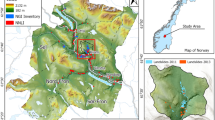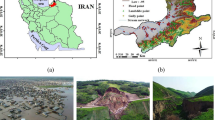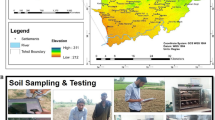Abstract
During the catastrophic failure process, the landslide mass emits low-frequency infrasonic waves, which are characterized by strong penetrating power, low energy attenuation, and long propagation distance, providing a basis for the long-range passive monitoring of the landslide infrasound signal. However, current landslide infrasound monitoring technologies are affected by environmental interference noise and frequently produce false positives. To improve the accuracy of landslide infrasound signal recognition, the monitoring signal needs to be analyzed to determine whether it is a landslide infrasound signal. To this end, this study collected numerous infrasound signals generated in the failure processes of landslide masses of different soil types under different degrees of consolidation through laboratory landslide simulation tests. Furthermore, various types of environmental interference infrasound signals in mountainous areas were gathered by field observations. These signals were divided randomly into training sets and test sets according to a ratio of 3:2. Through the feature analysis of the training set data, the typical features of the landslide infrasound and the environmental interference infrasound in both time and frequency domains were summarized. By constructing the feature vector set and regularization process, as well as using technical means such as the K-nearest neighbor (KNN) classification algorithm, Python, Matlab, and database, an intelligent landslide infrasound signal recognition system was developed. The performance of the recognition system was verified using the test set data. The verification results showed that the system has high recognition accuracy and computational efficiency and can meet the accuracy and real-time requirements of landslide infrasound monitoring. In addition, the recognition results of the system can provide an accurate signal source and reliable information support for landslide infrasound early warning.










Similar content being viewed by others
References
Arattano M, Marchi L, Cavalli M (2012) Analysis of debris-flow recordings in an instrumented basin: confirmations and new findings. Nat Hazards Earth Syst Sci 12(3):679–686. https://doi.org/10.5194/nhess-12-679-2012
Brachet N, Brown D, Le BR, Cansi Y, Mialle P, Coyne J (2010) Monitoring the Earth’s atmosphere with the global IMS infrasound network. In: Le Pichon A, Blanc E, Hauchecorne A (eds) Infrasound monitoring for atmospheric studies. Infrasound monitoring for atmospheric studies. Springer, Dordrecht, pp 77–118. https://doi.org/10.1007/978-1-4020-9508-5_3
Chou HT, Cheung YL, Zhang SC (2007) Calibration of infrasound monitoring system and acoustic characteristics of debris-flow movement by field studies. In: Debris-flow hazards mitigation: mechanics, prediction, and assessment. Millpress, Rotterdam, pp 571–580
Chou HT, Chang YL, Zhang SC (2013) Acoustic signals and geophone response of rainfall-induced debris flows. J Chin Inst Eng 36(3):335–347. https://doi.org/10.1080/02533839.2012.730269
Christie DR, Veloso JAV, Campus P, Bell M, Hoffmann T, Langlois A, Martysevich P, Demirovic E, Carvalho J (2001) Detection of atmospheric nuclear explosions: the infrasound component of the international monitoring system. Kerntechnik 66(3):96–101
Cochran ES, Shearer PM (2006) Infrasound events detected with the Southern California Seismic Network. Geophys Res Lett 33(19):L19803. https://doi.org/10.1029/2006GL026951
Comey RH, Mendenhall T (2004) Recent studies using infrasound sensors to remotely monitor avalanche activity. International Snow Science Workshop Proceedings, Jackson, WY, pp 640–646
Cui WJ, Teng PX, Han BK (2018) Characteristics of infrasound signals just before landslide. Tech Acoust 37(2):157–162
Drob DP, Meier RR, Picone JM, Garcés MM (2010) Inversion of infrasound signals for passive atmospheric remote sensing. In: Le Pichon A, Blanc E, Hauchecorne A (eds) Infrasound monitoring for atmospheric studies. Springer, Dordrecht, pp 701–731. https://doi.org/10.1007/978-1-4020-9508-5_24
Evers LG (2008) The inaudible symphony: on the detection and source identification of atmospheric infrasound. Thesis for Degree of Doctor of Delft University of Technology, Netherlands
He MC (2009) Real-time remote monitoring and forecasting system for geological disasters of landslides and its engineering application. Chin J Rock Mech Eng 28(6):1081–1090 (In Chinese)
Hu M (2015) Study on SPH movement model and monitoring method of soil landslide. Thesis for Degree of Doctor of University of Science and Technology Beijing. (In Chinese)
Hübl J, Zhang SC, Kogelnig A (2008) Infrasound measurements of debris flow. WIT Transactions on Engineering Sciences, Second International Conference on Monitoring, Simulation, Prevention and Remediation of Dense and Debris Flows II 60:3–12. https://doi.org/10.2495/DEB080011
Johnson JB (2003) Generation and propagation of infrasonic airwaves from volcanic explosions. J Volcanol Geotherm Res 121(1):1–14
Kogelnig A, Hübl J, Suriñach E, McArdell BW (2011) A study of infrasonic signals of debris flow. Proceedings of 5th international conference on debris-flow hazards: mitigation, mechanics, prediction and assessment: 563-572. https://doi.org/10.4408/IJEGE.2011-03.B-062
Krasnov VM, Drobzheva YV (2005) The acoustic field in the ionosphere caused by an underground nuclear explosion. J Atmos Sol Terr Phys 67(10):913–920. https://doi.org/10.1016/j.jastp.2005.02.014
Le Pichon A, Herry P, Mialle P, Vergoz J, Brachet N, Garcés M, Drob D, Ceranna L (2005) Infrasound associated with 2004–2005 large Sumatra earthquakes and tsunami. Geophys Res Lett 32(19):L19802. https://doi.org/10.1029/2005GL023893
Le Pichon A, Blanc E, Hauchecorne A (2010) Infrasound monitoring for atmospheric studies. Springer Science & Business Media. https://doi.org/10.1007/978-1-4020-9508-5
Li CA, Hu YW, Wang LW (2012) Infrasound monitoring and early warning of debris flow along montanic railway line. Tech Acoust 31(4):351–356 (In Chinese)
Lin L, Yang YC (2010) Observation & study of a kind of low-frequency atmospheric infrasonic waves. ACTA ACUSTICA 35(2):200–207 (In Chinese)
Liu DL, Leng XP, Wei FQ, Zhang SJ, Hong Y (2015) Monitoring and recognition of debris flow infrasonic signals. J Mt Sci 12(4):797–815
Liu DL, Leng XP, Wei FQ, Zhang SJ, Hong Y (2018) Visualized localization and tracking of debris flow movement based on infrasound monitoring. Landslides 15(5):879–893. https://doi.org/10.1007/s10346-017-0898-4
Lv J, Guo Q, Feng HN, Teng PX, Yang YC (2012) Anomalous infrasonic waves before a small earthquake in Beijing. Chin J Geophys 55(10):3379–3385 (In Chinese)
Matoza RS, Hedlin MAH, Garcés MA (2007) An infrasound array study of Mount St. Helens. J Volcanol Geothermal Res 160(3):249–262. https://doi.org/10.1016/j.jvolgeores.2006.10.006
Qing JH, Cheng YX, Pang XL (2013) Analysis of the characteristics of the background noise from a nuclear explosion monitoring. Nucl Electron Detect Technol 33(5):594–597 (In Chinese)
Ren JZ (2012) Research of landslide monitoring early warning based on sonic technology. Thesis for Degree of Master of Chengdu University of Technology. (In Chinese)
Ripepe M, De Angelis S, Lacanna G, Voight B (2010) Observation of infrasonic and gravity waves at Soufrière Hills Volcano, Montserrat. Geophys Res Lett 37(19):L00E14. https://doi.org/10.1029/2010GL042557
Scott ED, Hayward CT, Kubichek RF, Hamann JC, Pierre JW, Comey B, Mendenhall T (2004) Results of recent infrasound avalanche monitoring studies. Proceedings: International Snow Science Workshop, Jackson Hole, Wyoming, pp 696–704
Scott ED, Hayward CT, Kubichek RF, Hamann JC, Pierre JW, Comey B, Mendenhall T (2007) Single and multiple sensor identification of avalanche-generated infrasound. Cold Reg Sci Technol 47(1):159–170. https://doi.org/10.1016/j.coldregions.2006.08.005
Su F, Tian W (2002) Measurement of three-dimensional dynamic frequency spectra of infrasonic waves produced by winds with 4-8 wind scales. J Univ Petroleum, China 26(1):108–111 (In Chinese)
Tong N (2003) Features and applications of infrasound. Tech Acoust 22(3):199–202 (In Chinese)
Ulivieri G, Marchetti E, Ripepe M, Chiambretti I, Rosa GD, Segor V (2011) Monitoring snow avalanches in northwestern Italian Alps using an infrasound array. Cold Reg Sci Technol 69(2):177–183. https://doi.org/10.1016/j.coldregions.2011.09.006
Zhang SC, Yu NY (2008) Infrasonic behavior of debris flow and infrasonic warning device. In SS Chernomorets. Proceeding of international conference: debris flow: disasters, risk, forecast, protection, Pyatigorsk, Russia, pp 22–29
Zhang SC, Yu NY (2010) Early warning system to debris flow. J Mt Sci 28(3):379–384. https://doi.org/10.3969/j.issn.1008-2786.2010.03.017 (in Chinese)
Zhang SJ, Wang K, Hu KH, Xu HQ, Xu CX, Liu DL, Lv J, Wei FQ (2020) Model test: infrasonic features of porous soil masses as applied to landslide monitoring. Eng Geol 265:105454. https://doi.org/10.1016/j.enggeo.2019.105454
Zhu X (2014) Study on characteristics and detecting technology of infrasonic signal produced by rock fracture. Thesis for Degree of Doctor of Chengdu University of Technology. (In Chinese)
Zhu X, Xu Q, Tang MG, Fu XM, Zhou JB (2013) Experimental study of infrasound wave generated by typical rock fracture. Rock Soil Mech 34(5):1306–1312 (In Chinese)
Acknowledgments
This research is supported by the National Key Research and Development Program of China (No. 2018YFC1505205) and the Project of the Department of Science and Technology of Sichuan Province (No. 2019YFG0505 and 2018JY0456) and the Scientific Research Fund Sichuan Provincial Education Department (No. 18ZA0091). In addition, we appreciate the great help from Wu Fei and Gao Yan in the revision of the article.
Author information
Authors and Affiliations
Corresponding author
Rights and permissions
About this article
Cite this article
Liu, D., Tang, D., Zhang, S. et al. Method for feature analysis and intelligent recognition of infrasound signals of soil landslides. Bull Eng Geol Environ 80, 917–932 (2021). https://doi.org/10.1007/s10064-020-01982-w
Received:
Accepted:
Published:
Issue Date:
DOI: https://doi.org/10.1007/s10064-020-01982-w




